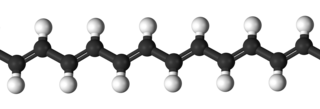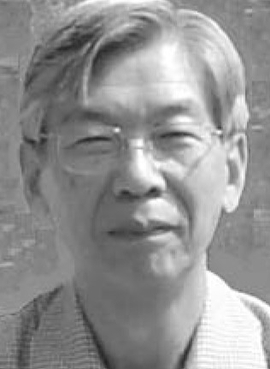Related Research Articles

Polymer science or macromolecular science is a subfield of materials science concerned with polymers, primarily synthetic polymers such as plastics and elastomers. The field of polymer science includes researchers in multiple disciplines including chemistry, physics, and engineering.
Carl Shipp "Speed" Marvel was an American chemist who specialized in polymer chemistry. He made important contributions to U.S. synthetic rubber program during World War II, and later worked at developing polybenzimidazoles, temperature-resistant polymers that are used in the aerospace industry, in fire-fighting equipment, and as a replacement for asbestos. He has been described as "one of the world's outstanding organic chemists" and received numerous awards, including the 1956 Priestley Medal and the 1986 National Medal of Science, presented by President Ronald Reagan.

The Charles Goodyear Medal is the highest honor conferred by the American Chemical Society, Rubber Division. Established in 1941, the award is named after Charles Goodyear, the discoverer of vulcanization, and consists of a gold medal, a framed certificate and prize money. The medal honors individuals for "outstanding invention, innovation, or development which has resulted in a significant change or contribution to the nature of the rubber industry". Awardees give a lecture at an ACS Rubber Division meeting, and publish a review of their work in the society's scientific journal Rubber Chemistry and Technology.
The Melvin Mooney Distinguished Technology Award is a professional award conferred by the ACS Rubber Division. Established in 1983, the award is named after Melvin Mooney, developer of the Mooney viscometer and of the Mooney-Rivlin hyperelastic law. The award consists of an engraved plaque and prize money. The medal honors individuals "who have exhibited exceptional technical competency by making significant and repeated contributions to rubber science and technology".

Rubber Chemistry and Technology is a quarterly peer-reviewed scientific journal covering fundamental research and technical developments relating to chemistry, materials science, and engineering of rubber, elastomers, and related materials. It was established in 1928, with Carroll C. Davis as its first editor-in-chief. The current editor-in-chief is Christopher G. Robertson. The journal is published by the ACS Rubber Division. The journal currently publishes four issues per year containing original research contributions and review articles.

Maurice Morton was a polymer author, educator, and researcher. He was the first director of the University of Akron's Institute of Rubber Research, which in 1993 was renamed the Maurice Morton Institute of Polymer Science.
Samuel Emmett Horne Jr. was a research scientist at B. F. Goodrich noted for first synthesizing cis-1,4-polyisoprene, the main polymer contained in natural tree rubber, using Ziegler catalysis. Earlier attempts to produce synthetic rubber from isoprene had been unsuccessful, but in 1955, Horne prepared 98 percent cis-1,4-polyisoprene via the stereospecific polymerization of isoprene. The product of this reaction differs from natural rubber only slightly. It contains a small amount of cis-1,2-polyisoprene, but it is indistinguishable from natural rubber in its physical properties.
Charles Michael Roland was Head of the Polymer Physics Section at the Naval Research Lab in Washington DC from 1989 to 2015. His research was concerned primarily with the dynamics of condensed matter, including polymers and liquid crystals, with applications to military armor and infrastructure protection. He is noted for his development of elastomeric coatings for blast protection, and for diverse accomplishments in the field of elastomer science. From 1991-1999, he served as the 8th editor of the scientific journal Rubber Chemistry and Technology, and a Fellow of the American Physical Society and the Institute of Materials, Minerals, and Mining (UK).
Aubert Y. Coran (1932-2020) was an American scientist noted for his contributions to thermoplastic elastomers and vulcanization chemistry of rubber. In 1983, he won the Melvin Mooney Distinguished Technology Award, bestowed by the American Chemical Society to individuals "who have exhibited exceptional technical competency by making significant and repeated contributions to rubber science and technology". In 1995, the rubber division of the American Chemical Society bestowed on Coran the Charles Goodyear Medal in honor of his international contributions to polymer science and development.
Jack L. Koenig (1933–2021) was an American chemical engineer noted for pioneering spectroscopic methods of polymer characterization. He played a significant role in developing characterization methods to provide fundamental structure-property relationships for polymers used in thermoplastic and thermoset systems.
The purpose of the Sparks–Thomas Award, given by the ACS Rubber Division, is to recognize and encourage outstanding contributions and innovations in the field of elastomers by younger scientists, technologists, and engineers. The award is named for Exxon scientists William J. Sparks and Robert M. Thomas, co-inventors of Butyl rubber.
Roderic Quirk is an Emeritus University of Akron professor noted for contributions to anionic polymerization technology that is used to produce butadiene, isoprene and styrene homo and block copolymers.
Judit Puskas is a Distinguished Ohio State University professor noted as co-inventor of the polymer used on the Taxus-brand coronary stent. She is the first woman to win the Charles Goodyear Medal, the highest honor conferred by the American Chemical Society's Rubber Division. Her research focuses on polymer engineering for breast reconstruction in cancer treatment, green polymer chemistry, biomimetic processes, biomaterials, living polymerization, polymerization mechanisms and kinetics, thermoplastic elastomers, polymer structure/property relationships, and polymer-bio interfaces.
Georg Bohm is a retired Vice President of Research and Technology for Bridgestone Americas noted for the development of electron beam pre-curing of elastomers.
Nissim Calderon was a Goodyear executive and scientist, noted for his introduction of olefin metathesis in 1967. His work on olefin metathesis led to the 2005 Nobel Prize in Chemistry.

Prof. Yasuyuki Tanaka was a Tokyo University of Agriculture and Technology professor noted for elucidating the molecular structure of natural rubber, and for his work in synthetic rubber.
Walter H. Waddell is a retired ExxonMobil Chemical senior research associate and consultant to the tire and rubber industry with expertise in silica technology, rubber compounding, butyl polymer applications and tire aging. Since 2015 he has served on the technical committee of the International Tire Exhibition & Conference (ITEC) for Tire Manufacturing.
Henry L. Hsieh was a Phillips Petroleum scientist known for contributions to polymerization chemistry, specifically anionic polymerization
Howard A. Colvin is an organic chemist and consultant to the tire and rubber industries noted for developments in rubber chemicals and polymers, and for his DOE-funded work on using guayule rubber in tires.
David A. Benko is a retired Goodyear chemist and materials R&D director.
References
- ↑ Kuczkowski, Joseph A. (2011). "Stabilization of Raw Dienic Synthetic Rubber Polymers". Rubber Chemistry and Technology. 84 (3): 273–295. doi:10.5254/1.3592280.
- ↑ Dr. Joseph A. Kuczkowski, 2011 Charles Goodyear Medalist, Rubber Chemistry and Technology, vol. 84, G2-G3, 2011.
- ↑ "Kuczkowski receives Charles Goodyear Medal". Rubber and Plastics News. Crain. 19 April 2011. Retrieved 2 February 2024.
- ↑ "Kuczkowski wins Charles Goodyear Medal". Rubber and Plastics News. Crain. 12 October 2010. Retrieved 2 February 2024.